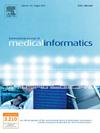Predicting and validating the risk of interstitial lung disease in systemic lupus erythematosus
IF 3.7
2区 医学
Q2 COMPUTER SCIENCE, INFORMATION SYSTEMS
International Journal of Medical Informatics
Pub Date : 2025-02-14
DOI:10.1016/j.ijmedinf.2025.105839
引用次数: 0
Abstract
Objective
Our study aimed to construct a web-based calculator to predict high risk patients of interstitial lung disease (ILD) in systemic lupus erythematosus (SLE).
Methods
This retrospective study comprised training and test cohorts, including 581 and 86 patients, respectively. Univariate, least absolute shrinkage and selection operator (LASSO), random forest (RF), eXtreme Gradient Boosting (XGBoost), and logistic regression (LR) analyses were performed. A Venn diagram was used to investigate critical features. Receiver operating characteristic (ROC) analysis and decision curve analysis were used to evaluate the model’s performance. Risk stratification was performed using the best ROC cut-off value. The web-based calculator was established using Streamlit software.
Results
Characteristics such as Raynaud’s phenomenon, pulmonary artery systolic pressure, serositis, anti-U1RNP antibodies, anti-Ro52 antibodies, C-reactive protein, age, and disease course were associated with SLE complicated by ILD (SLE-ILD). LR-Venn, RF-Venn, XGBoost-Venn, LASSO-logic, RF, and XGBoost models were constructed. In training cohort, the XGBoost model demonstrated the highest area under the ROC curve (AUC, 0.890; cut-off value, 0.197; sensitivity, 0.793; specificity, 0.836) and provided a net benefit in decision curve analysis (odds ratio [OR] for SLE-ILD [high- vs. low-risk], 19.6). The model was validated in the test cohort (AUC, 0.866; sensitivity, 0.722; specificity, 0.897; OR, 22.7). Furthermore, an XGBoost model-based web calculator was developed.
Conclusion
Our web calculator (https://st-xgboost-app-kcv9qm.streamlit.app/) greatly improved risk prediction for SLE-ILD and was implemented effectively.
预测和验证系统性红斑狼疮间质性肺疾病的风险
目的建立一个基于网络的预测系统性红斑狼疮(SLE)间质性肺疾病(ILD)高危患者的计算器。方法回顾性研究包括训练组和测试组,分别包括581例和86例患者。进行了单变量、最小绝对收缩和选择算子(LASSO)、随机森林(RF)、极端梯度增强(XGBoost)和逻辑回归(LR)分析。使用维恩图来研究关键特征。采用受试者工作特征(ROC)分析和决策曲线分析来评价模型的性能。采用最佳ROC临界值进行风险分层。利用Streamlit软件建立了基于网络的计算器。结果雷诺现象、肺动脉收缩压、血清炎、抗u1rnp抗体、抗ro52抗体、c反应蛋白、年龄、病程等特征与SLE合并ILD (SLE-ILD)相关。构建了LR-Venn、RF- venn、XGBoost- venn、LASSO-logic、RF和XGBoost模型。在训练队列中,XGBoost模型的ROC曲线下面积最大(AUC, 0.890;临界值为0.197;敏感性,0.793;特异性,0.836),并在决策曲线分析中提供净收益(slel - ild的优势比[OR][高与低风险],19.6)。该模型在检验队列中得到验证(AUC, 0.866;敏感性,0.722;特异性,0.897;或者,22.7)。在此基础上,开发了基于XGBoost模型的网络计算器。结论我们的网络计算器(https://st-xgboost-app-kcv9qm.streamlit.app/)大大提高了slel - ild的风险预测效果,并得到了有效的应用。
本文章由计算机程序翻译,如有差异,请以英文原文为准。
求助全文
约1分钟内获得全文
求助全文
来源期刊

International Journal of Medical Informatics
医学-计算机:信息系统
CiteScore
8.90
自引率
4.10%
发文量
217
审稿时长
42 days
期刊介绍:
International Journal of Medical Informatics provides an international medium for dissemination of original results and interpretative reviews concerning the field of medical informatics. The Journal emphasizes the evaluation of systems in healthcare settings.
The scope of journal covers:
Information systems, including national or international registration systems, hospital information systems, departmental and/or physician''s office systems, document handling systems, electronic medical record systems, standardization, systems integration etc.;
Computer-aided medical decision support systems using heuristic, algorithmic and/or statistical methods as exemplified in decision theory, protocol development, artificial intelligence, etc.
Educational computer based programs pertaining to medical informatics or medicine in general;
Organizational, economic, social, clinical impact, ethical and cost-benefit aspects of IT applications in health care.
 求助内容:
求助内容: 应助结果提醒方式:
应助结果提醒方式:


